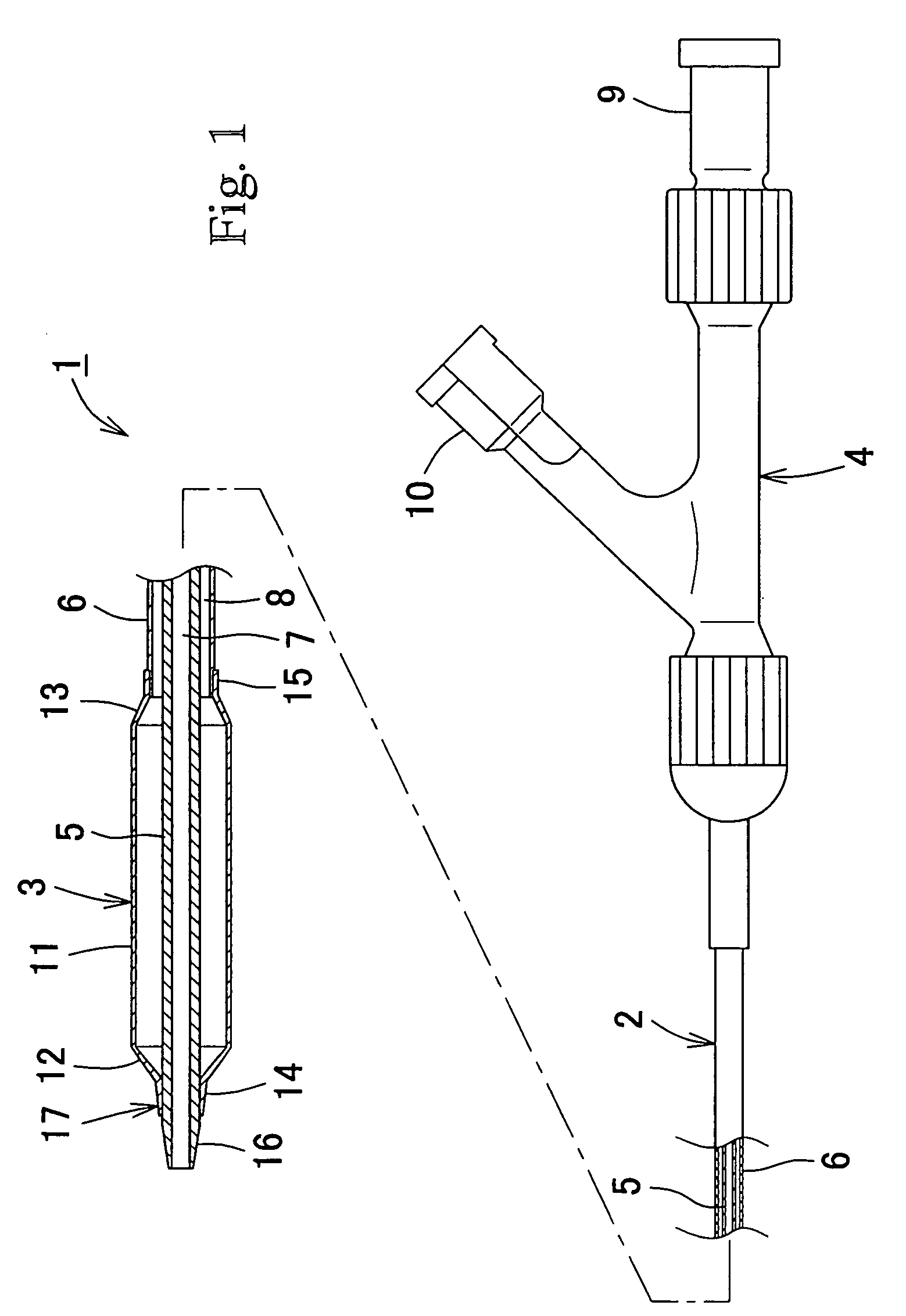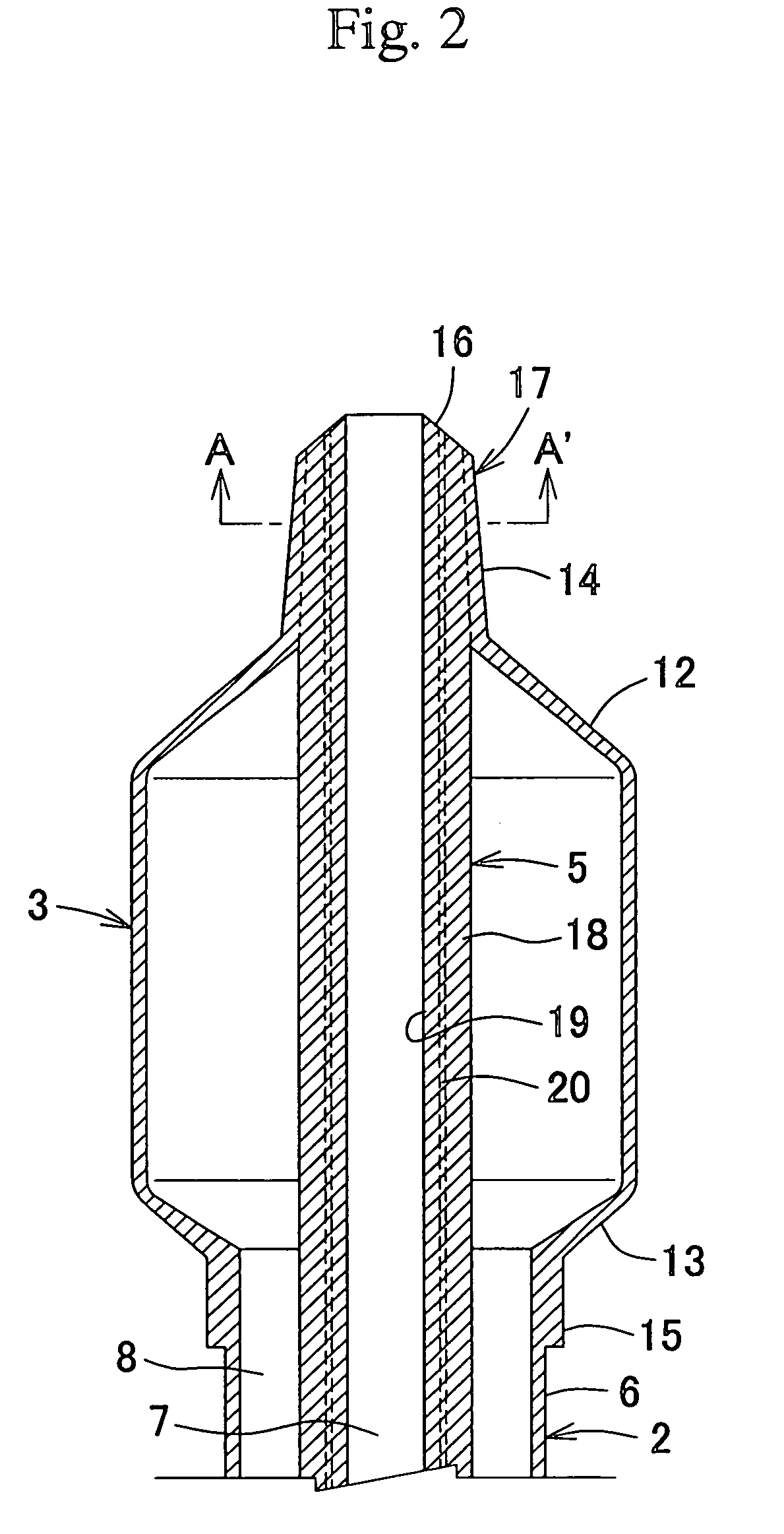Balloon catheter
a balloon catheter and balloon technology, applied in balloon catheters, other medical devices, surgery, etc., can solve the problems of large decline in controllability, significant increase in proportion, and large decrease in controllability
- Summary
- Abstract
- Description
- Claims
- Application Information
AI Technical Summary
Benefits of technology
Problems solved by technology
Method used
Image
Examples
embodiment 1
[0089]A rapid exchange type balloon catheter for use in coronary arteries having a catheter distal portion as diagrammed in FIG. 2 was fabricated by passing a first tubular member for passing a guide wire, having the layer forming the outermost surface configured from a polyester elastomer having a Shore hardness of 60D, flexural modulus of 274 Mpa, melting point of 216° C., and soft segment ratio of 22% and the innermost surface configured from a high-density polyethylene through the interior of a balloon having a nominal inflated diameter of 3.0 mm formed from a polyester elastomer having a Shore hardness of 72D, flexural modulus of 568 MPa, melting point of 218° C., and soft segment ratio of 13%, and fusing the outer surface of that first tubular member concentrically at the distal-side leading end of the balloon. In this Embodiment 1, furthermore, a second tubular member configuring the catheter outer surface connected to the proximal side of the balloon was configured of a poly...
embodiment 2
[0090]A rapid exchange type balloon catheter for use in coronary arteries having a catheter distal portion as diagrammed in FIG. 2 was fabricated by passing a first tubular member for passing a guide wire, having the layer forming the outermost surface configured from a polyamide elastomer having a Shore hardness of 55D, flexural modulus of 196 Mpa, melting point of 168° C., and soft segment ratio of 35% and the innermost surface configured from a high-density polyethylene through the interior of a balloon having a nominal inflated diameter of 3.0 mm formed from a polyamide elastomer having a Shore hardness of 70D, flexural modulus of 430 MPa, melting point of 172° C., and soft segment ratio of 14%, and fusing the outer surface of that first tubular member concentrically at the distal-side leading end of the balloon. In this Embodiment 2, furthermore, a second tubular member configuring the catheter outer surface connected to the proximal side of the balloon was configured of a poly...
embodiment 3
[0091]A rapid exchange type balloon catheter for use in coronary arteries having a catheter distal portion as diagrammed in FIG. 7 was fabricated by passing a first tubular member for passing a guide wire, having the layer forming the outermost surface of the portion fused with the balloon configured from a polyamide elastomer having a Shore hardness of 40D, flexural modulus of 93 Mpa, melting point of 168° C., and soft segment ratio of 47% and the innermost surface of the portion fused with the main body and balloon configured from a high-density polyethylene through the interior of a balloon having a nominal inflated diameter of 3.0 mm formed from a polyamide elastomer having a Shore hardness of 70D, flexural modulus of 430 MPa, melting point of 172° C., and soft segment ratio of 14%, and fusing the outer surface of that first tubular member concentrically at the distal-side leading end of the balloon. The symbol 26 in FIG. 7 here indicates an opening for leading in the guide wire...
PUM
| Property | Measurement | Unit |
|---|---|---|
| angle of inclination | aaaaa | aaaaa |
| length | aaaaa | aaaaa |
| outer diameter | aaaaa | aaaaa |
Abstract
Description
Claims
Application Information
 Login to View More
Login to View More - R&D
- Intellectual Property
- Life Sciences
- Materials
- Tech Scout
- Unparalleled Data Quality
- Higher Quality Content
- 60% Fewer Hallucinations
Browse by: Latest US Patents, China's latest patents, Technical Efficacy Thesaurus, Application Domain, Technology Topic, Popular Technical Reports.
© 2025 PatSnap. All rights reserved.Legal|Privacy policy|Modern Slavery Act Transparency Statement|Sitemap|About US| Contact US: help@patsnap.com



